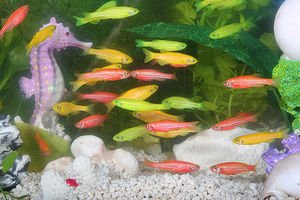When my youngest daughter was little everything was about pink. Everything she wore had to be pink and even her pink sunglasses had pink lenses. Stary Night”, her imaginary pink poodle had an imaginary litter in front of our gas fireplace. Her Aunt even nicknamed her “Pink” (no relation the famed singer-songwriter).
One day as we were walking to our car after a few hours of fun on the beach she asked me if she could have a pink pony. Not realizing the anguish that was about to ensue I explained to her that there was no such thing as pink ponies. No sooner had the words come out of my mouth than a stream of tears and mournful cries, which far belied by her small size, were released by my daughter. Our fellow beach combers looked at me with sideways glances and even a few glares, assuming that I had committed some egregious act of miss-parenting or even cruelty.
Since that day on the beach science has made great strides in genetic engineering of plants and animals. According to a 2010 report in brainwaving.com, “…80 per cent of soya grown worldwide is now genetically engineered…”1.
I recently wrote an article which included some information on transgenic goats that may be able to produce spider silk in their milk2. While goat produced spider silk is not yet commercially viable, the FDA has approved the breeding of genetically engineered goats which produce ATryn in their milk3. ATryn is used for the prevention of blood clots in patients with a disease known as hereditary antithrombin (AT) deficiency3. According to Jesse Goodman, M.D., M.P.H. This product offers an important new treatment option for patients with hereditary antithrombin deficiency, preventing life-threatening clots that otherwise frequently occur during high risk situations,”3 such as surgery. These goats have been closely tracked through at least seven generations with no evidence that the genetic modification has caused any adverse effects for them.
In 2002, National Geographic reported on mice that have been engineered to express a Jelly Fish Gene that causes their cells to fluoresce when exposed to blue light4. Every cell in the body contains the gene and will fluoresce, albeit there is some variation between individuals as to brightness of the fluorescence. Fluorescent mice are helpful in studying such diseases as Alzheimer’s. By looking at the pattern of fluorescence in the brain, researchers are able to determine the exact nerve clusters used in processing sensory input, even from a single whisker5 enabling much closer mapping of the brain. This information extrapolated to humans could provide light on “more effective treatments for neurological diseases such as Alzheimer’s5.”
In addition to “glow in the dark” mice, scientists have transformed a popular aquarium fish to fluoresce even in normal light. Zebra fish are fresh water tropical fish that are popular with aquarium hobbyists and have been used extensively in research. Scientists have added a natural fluorescence gene to Zebra fish in the hopes that the gene would be responsive to environmental pollutants. In the presence of pollutants the gene would turn on and the fish would fluoresce, no pollutants and the zebra fish would be indistinguishable from its natural cousins. So far scientists haven’t determined how to get the gene to respond to environmental stimuli, so these fish retain their brilliant colors full time making them popular with aquarium enthusiasts.
The potential benefits of transgenics and bioengineering to both animals and humans are infinite and these animals suffer no apparent ill effects from the genetic transformations. These benefits are much greater than just breeding pink ponies to bring a smile to a little girl’s face, but what would be so bad with that?
1. http://www.brainwaving.com/2010/07/28/genetically-modified-animals/
2. http://voices.yahoo.com/purring-cats-transgenic-goats-could-solve-space-10892931.html?cat=53
3. http://www.fda.gov/NewsEvents/Newsroom/PressAnnouncements/2009/ucm109074.htm
4. http://news.nationalgeographic.com/news/2002/01/0111_020111genmice.html
5. http://www.pittsburghlive.com/x/pittsburghtrib/s_203448.html
6. http://www.glofish.com/faq.asp#TheScienceofGloFish


